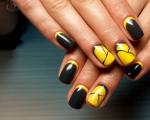Correct application of shellac: step-by-step instructions for beginners
The image of a beautiful, well-groomed woman consists of many components: hairstyle, clothes, shoes, face. It often happens that nails are somewhere at the end of the list - and this is wrong.
A neat manicure and well-groomed hands are the calling card of any woman. Peeling nail polish looks simply terrible, and there is simply no time to refresh it. Today this problem can be solved quite simply: shellac has become the most popular procedure in nail care salons.
But what to do if you don’t have enough time or money to go to the salon? Of course, there is a way out - this is to make shellac at home. For beginners, here are step-by-step instructions for this now popular manicure.
A beautiful word, by the way, does not conceal anything mysterious. Shellac is a waste product (in other words, excrement) of scale insects that feed on tree sap. This digested resinous substance is collected, dried and crushed, then the varnish mass is melted and cast into molds. The end result is a great manicure product.
Manicure has never been a special procedure, but the use of shellac has its own distinctive features. Firstly, the need for nail extensions disappears; secondly, the coating is quite durable and lasts much longer; thirdly, chic appearance and rich colors.
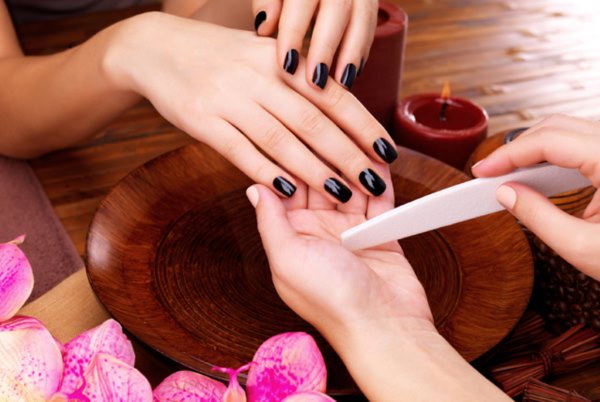 The disadvantage of shellac is primarily its cost.
The disadvantage of shellac is primarily its cost. The life of a manicure, no matter how elegant it may be, is very short. Housework is the responsibility of any woman; very few have au pairs. Daily cooking, washing dishes, laundry, cleaning - all this leads to the fact that nail polish quickly fades, cracks and loses its appearance.
Shellac is a different matter: a symbiosis of gel and varnish (even done at home by beginners in accordance with step-by-step instructions) lasts quite a long time, and during this period it becomes possible to further strengthen the nail plate.
Advantages and disadvantages of shellac
Shellac, as you may have guessed, has many advantages:
- Shellac manicure looks great on any nails: both long and short. At the same time, the painting method gives you a chance to grow your nails to the desired length.
- Since shellac is a natural product, it can strengthen thin and brittle nails.
- Shellac stays on your nails for a long time: some fashionistas manage to keep their manicure for up to three weeks.
- To remove shellac from nails, special products are needed, which means that household chemical products are not harmful to it.
- Shellac gives your nails a dazzling shine that lasts incredibly long and does not fade.
- Manufacturers closely follow fashion and the color palette of shellac is constantly expanding. On sale you can find not only classic tones for manicure, but also bright avant-garde paints.
- Perhaps the most important advantage of shellac is that it is absolutely harmless. Dangerous formaldehydes are not included in its composition, therefore women prone to allergies and pregnant women can safely do a shellac manicure.
If for some reason the coating suddenly becomes boring, then shellac can be removed at home. To do this, you need to buy special products, liquid and film at the salon, carefully study the step-by-step instructions for beginners and clean the nail plates yourself.
Everything in the world has its downside - and shellac is no exception:
- First of all, this concerns the high price of the procedure itself, and if there is a need for correction, then this is also quite expensive. So, if your nails grow too quickly, you will have to put up with additional expenses.
- The second negative factor is more significant. Shellac, as the manufacturer assures, is indeed a very durable coating. But nails tend to expand under the influence of high temperatures, and then shrink again, taking on their original size. So washing dishes in hot water or taking a bath that is too warm contributes to nail deformation and causes microscopic cracks in the coating.
Through these microscopic holes, dirt can get under the varnish layer, and dirt creates greenhouse conditions for many bacteria and microorganisms. Shellac lasts a long time, which means the bacilli have enough time to damage the nail. So fungus is not the most dangerous disease.
To avoid sad consequences, it is better to do all dirty housework with gloves.
What tools and equipment will be required?
Shellac is a very complex procedure, and it is best to do it in a salon, with an experienced specialist. But “it’s not the gods who burn the pots,” so if you have certain skills, you can do it yourself at home. To do this, you need to know step-by-step instructions for beginners and have special tools and ultraviolet lamp for drying manicure.
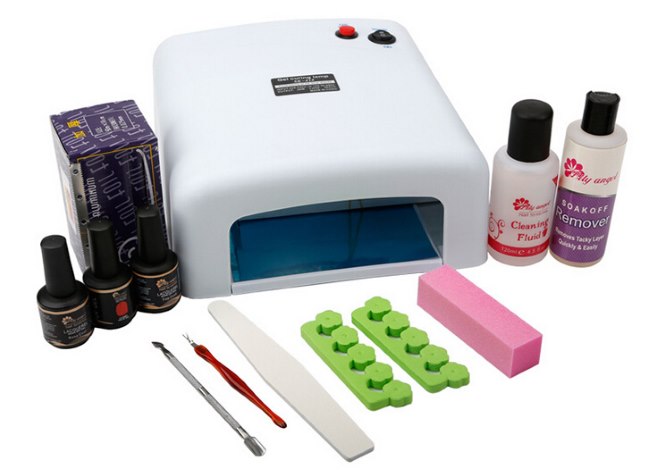 To apply shellac at home you will need some tools and supplies.
To apply shellac at home you will need some tools and supplies. First of all you will need: basis for applying the base coat, shellac coating and sealer. Professionals recommend using a base and base coat from the same shellac category, preferably from the same manufacturer. Otherwise, there is a risk that the desired result will not be achieved.
In addition, you must have:
- antibacterial agent;
- orange wood spatula or stick;
- nail file;
- manicure scissors;
- Bondex, a product for improved adhesion;
- cuticle cleaner;
- sanding file.
Preparing nails for shellac
So, having all the necessary tools for shellac at home (read about step-by-step application for beginners below), you can start preparing your nails.
 Before applying gel polish, you need to prepare your nails, treating the cuticle in particular.
Before applying gel polish, you need to prepare your nails, treating the cuticle in particular. The preliminary operation includes:
- processing of the cuticle and formation of the nail plate;
- grinding is a mandatory procedure that improves the adhesion of shellac directly to the nail;
- disinfection with an antibacterial liquid, which additionally degreases the nail and ensures uniform coverage;
- applying the base layer;
- heating with an ultraviolet lamp to fix the gel, at least 25-30 seconds for each nail.
How to make shellac at home. Step-by-step instructions for beginners
Now that the nails are ready, you can proceed to the actual applying shellac:
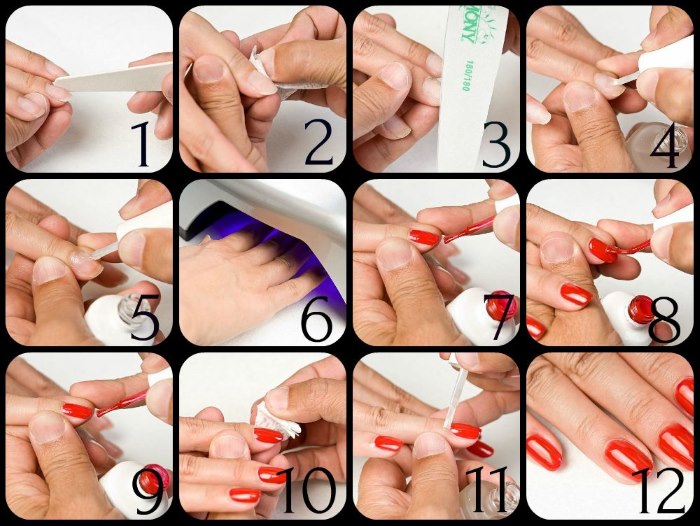
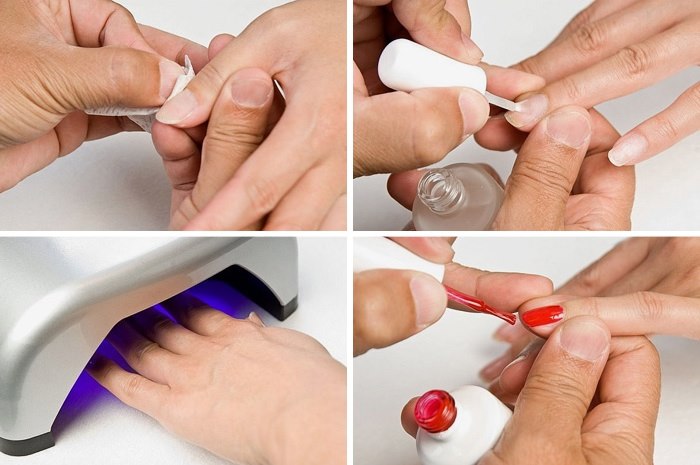 When making shellac at home according to step-by-step instructions for beginners on your own, you should know that There is no need to remove the sticky layer after the first and base coat, as this will enhance adhesion.
When making shellac at home according to step-by-step instructions for beginners on your own, you should know that There is no need to remove the sticky layer after the first and base coat, as this will enhance adhesion.
 After applying each layer of shellac, nails should be dried in a UV lamp.
After applying each layer of shellac, nails should be dried in a UV lamp. What will happen to your nails after applying shellac?
No matter how safe the shellac procedure is for nails, restorative measures are still necessary. After all, everyone changes their underwear every day, but the nail remains in a kind of shell for a long time. So, if yellowish spots appear on the surface of the nail plate or the nail is somewhat deformed, then urgent measures should be taken.
You can revive your nail in the master's salon or use home remedies, which is generally preferable because they are inexpensive and available:
- Make lotions from heated olive oil throughout the week. Nails will receive additional nutrition and hydration, which means they will maintain a healthy appearance.
- A piece of lemon, which should be rubbed daily on the surface of the nail, can work wonders. Essential oils and vitamin C will restore shine and eliminate flaking and brittleness.
- A bath with sea salt will get rid of a possible fungal infection. It is advisable to do the procedure every day, for 10-15 minutes.
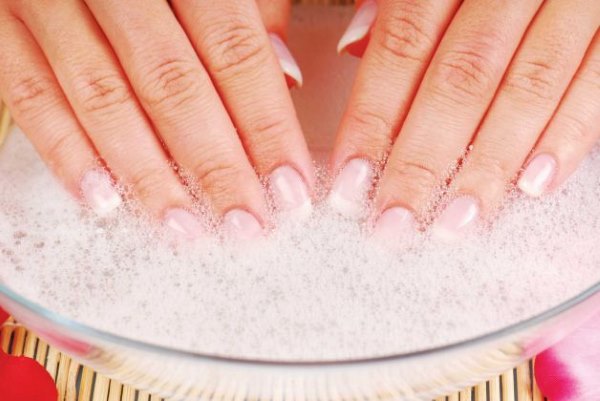 Sea salt baths are recommended for restoring the nail plate after shellac
Sea salt baths are recommended for restoring the nail plate after shellac Secrets of applying shellac at home
By making shellac at home yourself, following the step-by-step application technology for beginners, you can save a little. So, what means and tools can be replaced and with what:
- Manicurists use special products to remove cuticles, which are quite expensive. But if the cuticle is not too noticeable, then in this case you can use an orange stick to simply push it back.
- The grinder is completely replaced by a regular polishing file: the end result will be the same.
- A small bottle of salon disinfectant, which can cost about a thousand, can easily be replaced with nail polish remover or acetone.
- The base coating cannot be replaced, but in cosmetics stores you can find a suitable product that, among other things, also has a healing effect.
Take a couple more secrets of applying shellac at home.
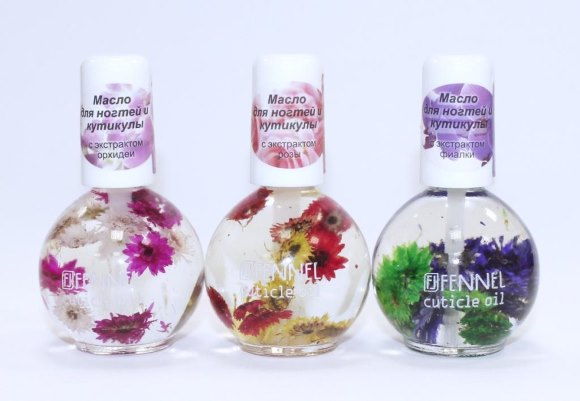 Cuticle oil should be used morning and evening every day
Cuticle oil should be used morning and evening every day Useful tips from professionals:
- When purchasing an ultraviolet lamp, you should pay attention to its power; the most optimal result is achieved when using a 36-watt lamp. In this case, the coating dries quite quickly.
- Before starting your manicure, roll the coated jar in your hands. This little trick will significantly improve the properties of the varnish, which will lie smoothly without much effort.
- To prevent shellac from thickening, it should be stored at room temperature, carefully closing the bottle after each use.
- Any corrective treatment should be carried out only under the obligatory condition: the nail must be dry. No soft file will protect a wet nail plate from damage.
- Use cuticle oil daily: morning and evening. Only in this case will you be able to avoid the appearance of sloppy hangnails.
- Before going to the salon to get your hands beautiful, you should treat your nails if necessary. Shellac can only aggravate the problem of brittleness and splitting of the nail plate.
- Do not apply hand cream immediately before a shellac manicure.
How to remove shellac gel correctly
To remove shellac manicure yourself at home(for beginners, step-by-step application is described above), you need to prepare:
- cotton pads or special sponges;
- 10 pieces of foil so that you can wrap your fingers;
- isopropyl alcohol or a special solution for dissolving shellac.
Before removing shellac, hands should be washed with warm water and soap and dried thoroughly.
 Shellac removal procedure
Shellac removal procedure Now you can start removing the shellac:
- Cut the cotton pads in half.
- Soak a piece of the disc in alcohol and apply it to the nail, secure with metal foil. Try to avoid getting alcohol on your skin to avoid causing irritation. Foil is used to prevent the alcohol from evaporating too quickly. You will have to wait about 15 minutes for the result, during which time you can lightly massage your fingertips for better penetration of the alcohol.
- In some cases, shellac is removed with a film; if this does not work, then it can be removed with an ordinary plastic spatula. It happens that, due to inexperience, the coating was applied in too thick a layer and the shellac cannot be removed. This means that you will have to repeat the procedure with alcohol or simply cut off the shellac.
- Finally, you should lubricate the nail with cuticle oil to avoid drying out the skin and nail surface.
Shellac is a wonderful product for manicure both in the salon and at home (you have already read the step-by-step instructions for beginners), your nails look neat, elegant and, importantly, natural.
Over time, experience and proper dexterity will come, and the whole procedure will not take too much time. As a result, your hands will look very attractive, and your nails will receive additional protection.
Shellac "Cat's Eye"
Cat eye nail design is very popular and looks very impressive. Using gel polish with the addition of a metal base and a magnet, you can get a pattern that really looks like a cat's eye.
For such a design you need to prepare green gel polish and special magnet. However, if there is no special one, then any ordinary one will do.
 Manicure "Cat's eye" can be done in any color scheme
Manicure "Cat's eye" can be done in any color scheme First, a base coat is applied to the nails., which must be dried in an ultraviolet lamp. The next layer is green, which is also dried. The magnet is not yet used.
But now a magnetic plate is brought to the second coating: metal particles of varnish are folded into an elegant pattern. If the magnet is held upside down, a stripe will form on the nails; but if you scroll it over the surface of the nail, the image will come out intricate, similar to a drawing of a cat's eye. Now all that remains is to complete the usual procedure.
It is not at all necessary to use only a green color palette: after all, a cat’s eyes can be yellow or even blue.
If you like the cat design, then you should buy a special magnet, with which you can get a spectacular pattern.
As you can see, shellac at home (for beginners, see step-by-step instructions above) is quite feasible. The main thing is to follow the instructions and not be afraid to fantasize.

